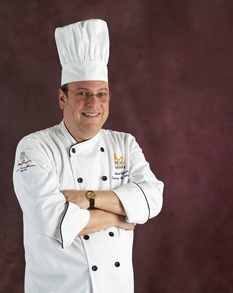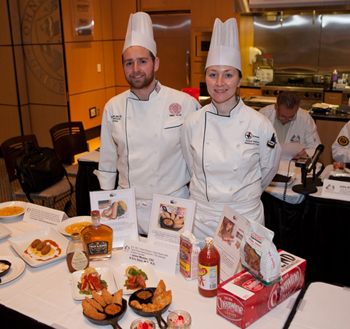Chefs Speak Out: Making Culinary Music
John C. Schopp cooks with jazz, creating an intimate communion with his guests that’s all about nourishing the essence of another human being.
By Lynn Schwartz
John Schopp, chef-owner of Center Stage Catering located in Rocky Mount, Va., believes that if you wrap your brain around what you want to do with your life, everything will fall into place. Doors open. Connections appear.
Schopp’s doors opened to music. Jazz. And while Schopp does play guitar, his path was not about making music, but about feeding the musicians. This is a task that he takes seriously and is fully present for, approaching his menus with the same artistic focus that is required of a musician when creating or performing a song.
Staying in Tune
Intent on nourishing the artist’s soul, Schopp views preparing a meal like making music. “A musician works from the beginning to the end of the song,” he says. “How they fill that space inside is what makes the music. It’s the same with food.”
Center Stage Catering’s website describes it even further, comparing its chefs to jazz musicians and the food they create to a well-executed jam session—fresh, spontaneous, playing off of each other and the audience energy—all within the parameters of the song. This approach to food has made all of Schopp’s clients, even those without musical talents, very happy.

 Says Chef Weiner, who will speak to this topic at the CAFÉ Leadership Conference in Miami in June, there are many benefits of person-to-person interaction that can’t be replicated by social networking.
Says Chef Weiner, who will speak to this topic at the CAFÉ Leadership Conference in Miami in June, there are many benefits of person-to-person interaction that can’t be replicated by social networking. The team of Eric Stein, MS, RD, CCE, a chef-instructor at the Kendall College School of Culinary Arts, and Jaime Mestan, CSC, a Kendall culinary alum (’08) and research chef at Ed Miniat, Inc., in South Holland, Ill., took second place, a silver medal and a cash award of $3,000 at the second-annual Professional Culinology® Competition, March 8 in Charlotte, N.C., held in conjunction with the Research Chefs Association’s (RCA) Annual Conference and Culinology Expo.
The team of Eric Stein, MS, RD, CCE, a chef-instructor at the Kendall College School of Culinary Arts, and Jaime Mestan, CSC, a Kendall culinary alum (’08) and research chef at Ed Miniat, Inc., in South Holland, Ill., took second place, a silver medal and a cash award of $3,000 at the second-annual Professional Culinology® Competition, March 8 in Charlotte, N.C., held in conjunction with the Research Chefs Association’s (RCA) Annual Conference and Culinology Expo. Frederic “Fritz” Sonnenschmidt, CMC, AAC, spent 34 years as a faculty member and dean of The Culinary Institute of America (CIA) before his retirement in 2002. More than a decade later, he returned to the college’s Hyde Park, N.Y., campus to deliver words of encouragement and inspiration to 69 recipients of associate degrees in culinary arts and baking and pastry arts.
Frederic “Fritz” Sonnenschmidt, CMC, AAC, spent 34 years as a faculty member and dean of The Culinary Institute of America (CIA) before his retirement in 2002. More than a decade later, he returned to the college’s Hyde Park, N.Y., campus to deliver words of encouragement and inspiration to 69 recipients of associate degrees in culinary arts and baking and pastry arts.